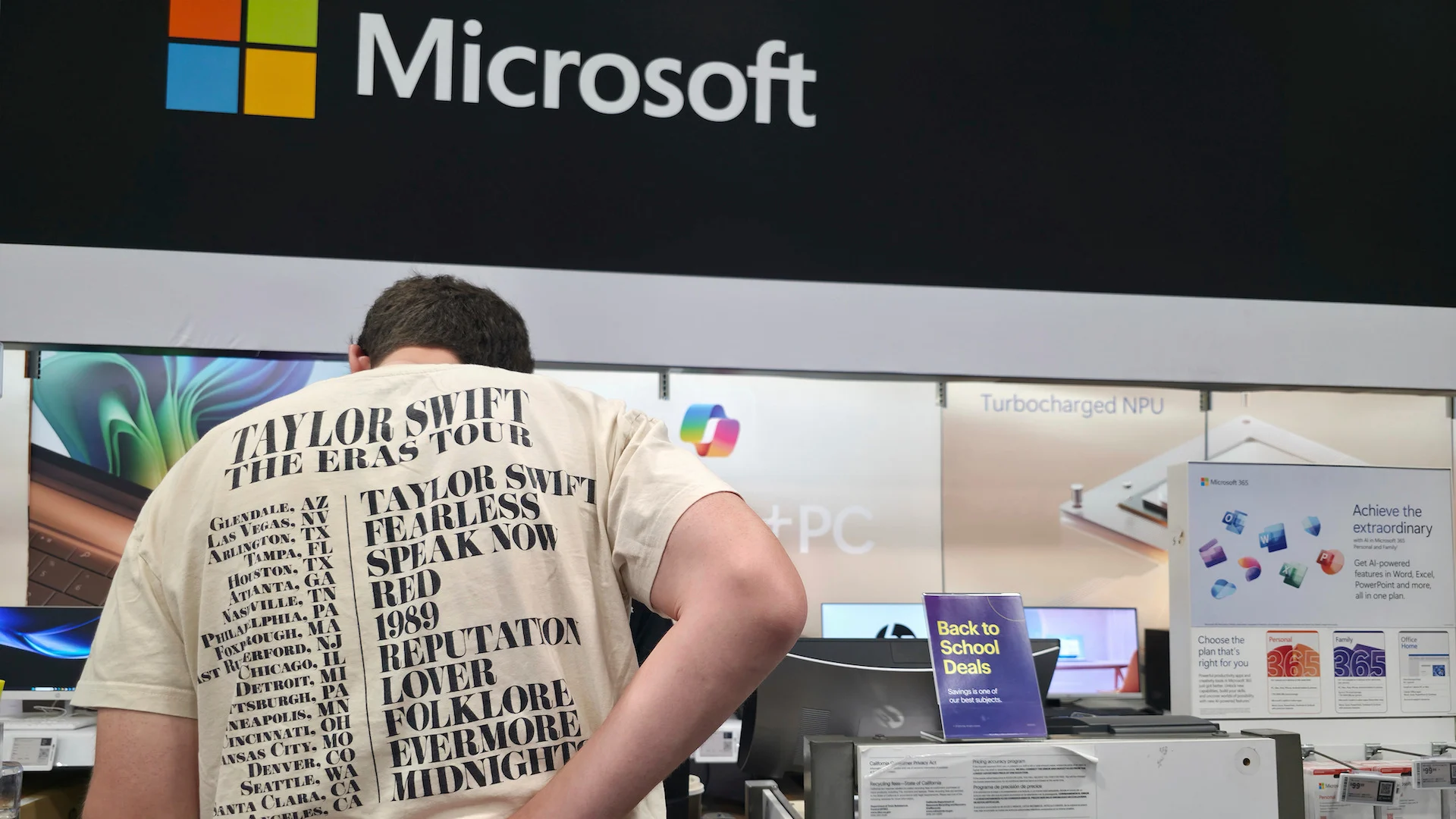Social media management for nonprofits often requires balancing limited resources against an expansive vision. Sure, larger nonprofits may have dedicated teams, and millions in advertising dollars and marketing assets, but smaller nonprofit teams are often expected to do much more with less.
While to some this could seem as a disadvantage, it isn’t. When compared to larger nonprofits, smaller nonprofits have a unique ability to connect with their audiences in an authentic way. According to a 2025 report, 98% of consumers say authentic photos and videos are key to building trust with a brand.
This guide is written to support lean nonprofit teams in establishing a sustainable and effective social media presence.
Source
Yes, Social Media Drives Donations
Social media doesn’t just build awareness it drives action. According to the Global Trends in Giving Report, 29% of online donors say social media is their top source of inspiration to give.
That’s nearly a third of your digital donors directly moved by a post, a reel, or a story you create. A single post can turn a casual user into a lifelong supporter who not only gives, but brings friends along too.
Platform-Specific Tips for Small Teams
Not every platform is right for every organization, and that’s okay. The key is choosing where your audience is and sharing content that is aligned with your mission. Here’s how to effectively use today’s leading platforms without burning out.
Owned by Meta, Instagram is a visually driven platform appealing to younger people; most users fall between the ages of 18 and 34.It’s perfect for visual storytelling, behind-the-scenes moments, and cause-driven engagement.
Engage your audience with Instagram Stories, and use Reels to reach a wider audience. You can also add donation stickers to Stories or your bio to turn views into action. Don’t worry about polished content because authenticity performs better than perfection here.
For example, a decade after the original Ice Bucket Challenge, U.S. college students revived the concept to spotlight mental health awareness. Celebrities like Peyton Manning have participated in the #SpeakYourMIND challenge, dousing themselves with ice water and sharing personal stories as well as educational resources. The campaign quickly went viral and raised over $338,000 in just a few days.

Source
LinkedIn offers a more professional space to showcase your nonprofit’s milestones, grants, and wins in leadership. Most LinkedIn users are between the ages of 25 and 34 years old. It’s a great way to interact with potential employees, board members, and donors.
Share success stories, program news, or thought leadership posts to position your organization as both credible and mission-driven. LinkedIn is also a great place to celebrate staff, promote culture, and attract serious supporters.
Facebook continues to be a top platform for nonprofits, particularly when reaching older audiences. With nearly 3 billion users and strong usage among people 35+, it’s ideal for promoting events, telling impact stories, and fundraising.
Nonprofits can create donation buttons, mobile giving platforms, host fundraisers directly on their page, or stream live events to engage supporters in real time. For smaller teams, scheduling posts in advance and using Facebook Groups can help build strong, ongoing community ties with minimal effort.
For example, Greenpeace’s #SaveOurPlanet campaign in 2024 emphasized climate justice and biodiversity conservation. Using augmented reality tools, the campaign illustrated real-time climate impacts. The campaign encouraged youth engagement through social media and partnerships with local NGOs to drive policy change.

Source
TikTok may not be for everyone. But it’s worth it, if your organization wants to reach Gen Z. The platform thrives on short, emotionally engaging, or humorous videos.
Think: showing the impact of your work, day-in-the-life clips from your volunteers, or mission moments that tug at the heart. That’s what earns attention and trust.
X (formerly Twitter) is best for real-time communication, advocacy pushes, and connecting with journalists, funders, or policymakers.
Use threads to discuss complex topics or tell micro-stories, and tag relevant partners or public figures to increase visibility. It’s okay to repurpose content and repeat key messages throughout the week. Consistency matters more than volume.
Show up with stories that matter, in the places where your audience already spends time. That’s how small teams grow lasting digital movements.
How to Create a Nonprofit Social Media Strategy
Your nonprofit can stay focused, save time, and turn small efforts into meaningful results.
Set SMART Goals
Small teams can achieve big wins with sharp focus. Start setting SMART goals—Specific, Measurable, Attainable, Relevant, and Time-bound. Instead of aims like “get more likes,” try something like, “Increase Facebook engagement by 25% over the next 60 days through weekly storytelling posts.”
Clear goals help you stay focused, measure progress, and align your team around a shared purpose. Align them with your broader mission whether it’s increasing awareness, recruiting volunteers, or boosting donations and you’ll have a powerful foundation to build from.
Measure Your Baseline and Set KPIs
Before you post a single image, know where you’re starting from. Look at your current engagement rates, follower growth, and website traffic. Using this baseline will allow you to understand your actual progress and when your tactic is working.
Define your KPIs Key Performance Indicators based on your goals. Whether it’s shares, comments, or conversion rates, these numbers will guide your team and keep your efforts data-driven. Don’t guess— track. If your nonprofit has an online store, performance isn’t just about social metrics. Website speed plays a crucial role in user experience and conversion rates. That’s why speed optimization should be part of your broader digital strategy—it helps ensure supporters don’t bounce due to slow load times, especially on mobile devices
Build an Audience Persona
Creating audience personas helps you clearly identify exactly who you are talking to – what they value, where they spend their time online and what drives them to support your cause.
Provide each persona with a name, a face and a related story. This is not mere fluff; it helps to refine your messaging and ensure your social media messaging strikes a chord every time. Instead, get to know your audience so you can speak to what truly matters to them.
For example, Plan International launched the #FutureGirlsWant campaign to promote gender equality worldwide. The initiative featured photos of girls sharing their dreams, provided ready-to-use social media templates for supporters, and included celebrities and influencers to expand reach and credibility.
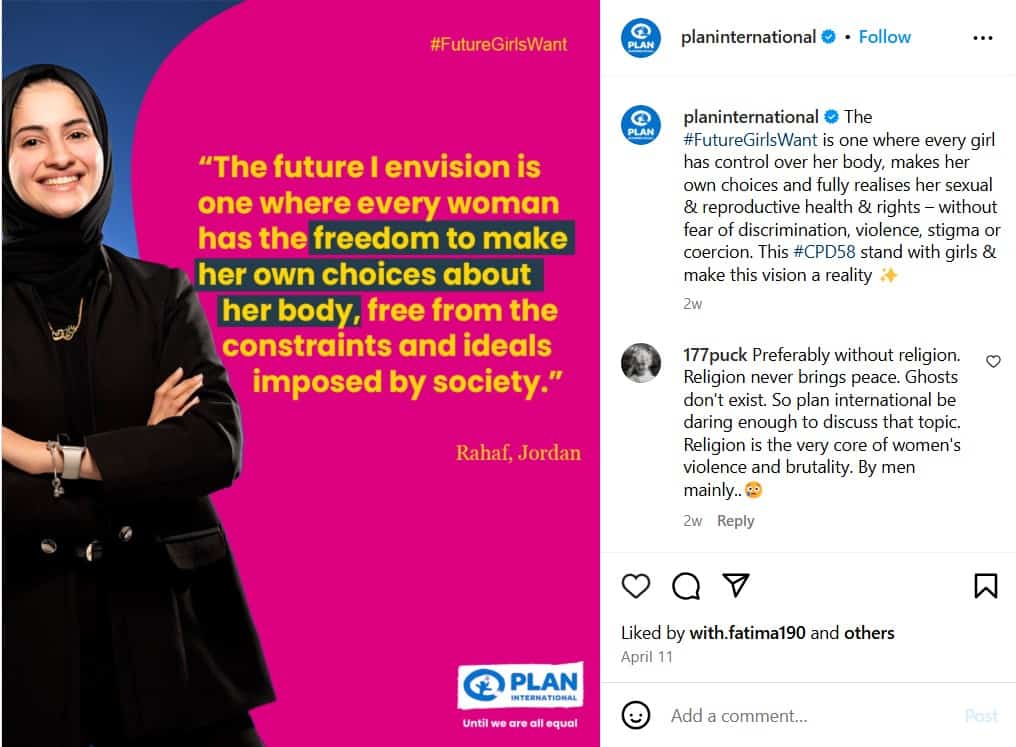
Source
Choose Your Social Media Networks
You don’t need to be on every platform, just the ones your audience uses most. For a small team, focusing on two or three platforms where your supporters are most active can lead to better engagement than stretching thin across five.
Use your audience persona and analytics to guide this choice. Animal rescue? Instagram might be gold. Professional development nonprofit? Try LinkedIn. Tailor your energy where it counts.
Create a Social Media Calendar
Ever feel like you’re scrambling for content? A social media calendar will help you stay consistent and organized. It brings structure to your posts, ensures consistency, and keeps your messaging in sync with events, campaigns, or donor drives.
Pre-planning content saves time and stress. Plan content around key moments and mix up formats like videos, stories, quotes, and CTAs to keep things fresh.
Create Great Content
Good content provides information, and great content inspires. Compelling stories are your biggest asset for smaller nonprofits. Use storytelling, powerful visuals, and testimonials to share how your work changes lives.
Don’t be afraid to use a consistent tone and style so your supporters recognize your voice. Use storytelling whether you are creating an Instagram story or a video for your YouTube page; let your mission shine. Content that resonates with the audience emotionally is content that gets shared.

Source
Repurpose and Curate Content
You don’t need to reinvent the wheel every week. Repurpose your best-performing content into new formats—a blog post becomes a tweet thread, a donor story turns into a Facebook video.
Also, don’t be afraid to curate. Sharing insightful content from credible sources also keeps your feed relevant and shows you’re part of a larger movement. It keeps your feed fresh and positions your organization as part of the bigger conversation.
Create an Effective Call-to-Action
Want your followers to act? Ask them clearly and directly. And don’t forget your call-to-action whether it’s a donation, sign-up, or event registration, a strong CTA turns interest into impact.
But keep it balanced. Mix promotional CTAs: use helpful, informative content so your feed doesn’t feel like a constant sales pitch. When people trust you, they’re more likely to take action.
Use Targeted Ads
When organic reach stalls, targeted ads can give you a boost without blowing your budget. Even $50 on a well-designed, well-targeted Facebook ad can bring in new supporters if it speaks to the right people.
Focus on ad content that matches your goals. Want volunteers? Highlight the impact of giving time. Want donors? Tell a story that shows their gift in action.
Engage With Your Audience
Reply to comments, answer messages, and let your followers know they’re appreciated. Even a basic thank you can turn a casual fan into an engaged advocate.
Create dialogues. Ask questions, create polls, and share UGC. Involve audiences in the conversation to strengthen connection, and a more engaged audience is more likely to stay with you.
In September 2022, Charity: Water’s “StreamForClean” campaign worked with gamers and digital creators to raise over $197,000 for clean water projects in Zimbabwe. The campaign maintained its present momentum with constant updates, reporting fundraising benchmarks, and highlighting those involved to keep the audience engaged, especially a younger audience who are more digital in nature.
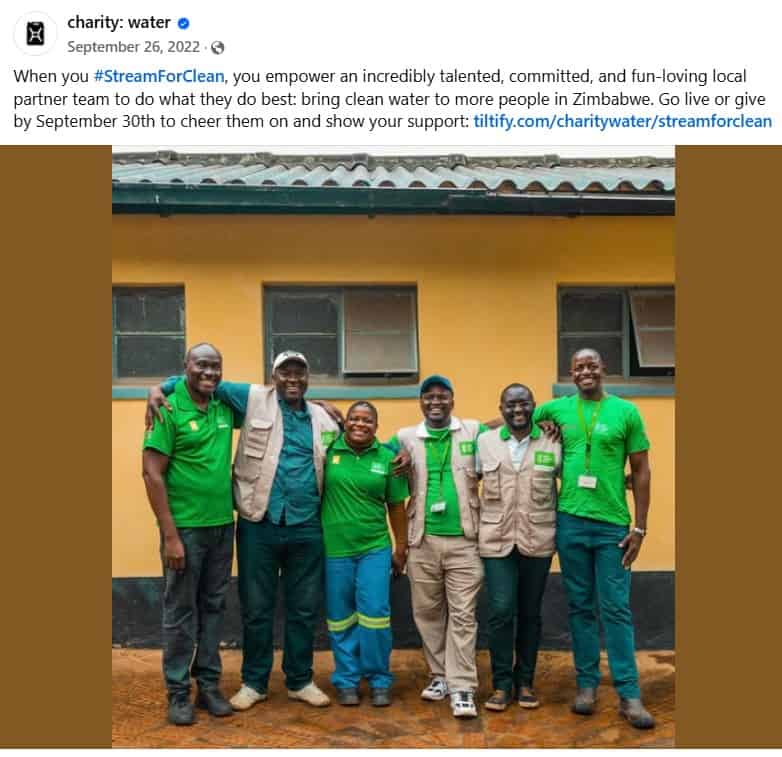
Source
Assess The Results
After all the posting, sharing, and storytelling, it’s time to pause and reflect. Did you meet your goals? What posts outperformed? What flopped?
Take this insight to shape your next campaign. Social success on social media isn’t luck, it’s about learning, adapting, and getting better every single time. Small teams can pull amazing things off if they spend even a small time analyzing the data.
Social Media Campaign Ideas for Nonprofits
Running a nonprofit with a small team can be overwhelming but you don’t need a big staff to make a big impact. These simple yet powerful social media ideas will help you boost reach without burning out your team.
Use Hashtags That Work Hard
Hashtags aren’t just trendy, they’re strategic. With great hashtags, especially on Instagram and X (formerly Twitter), you can extend your message, increase your audience, and assist supporters in finding and sharing your content. When you create a branded hashtag (for your organization or campaign) you will be able to easily track engagement and find user-generated content assuming they remember to tag you.
But don’t stop there. Combine your custom hashtags with popular, mission-aligned ones your audience already uses. This double approach boosts visibility while making your content easier to find, follow, and engage with.
See an example.
Bell Let’s Talk: Canadian mental health campaign. Every tweet with hashtag #BellLetsTalk results in a donation by Bell Canada. As of 2025, it has raised over $121 million and generated more than 1.3 billion interactions. The campaign has helped normalize mental health conversations and support countless programs.
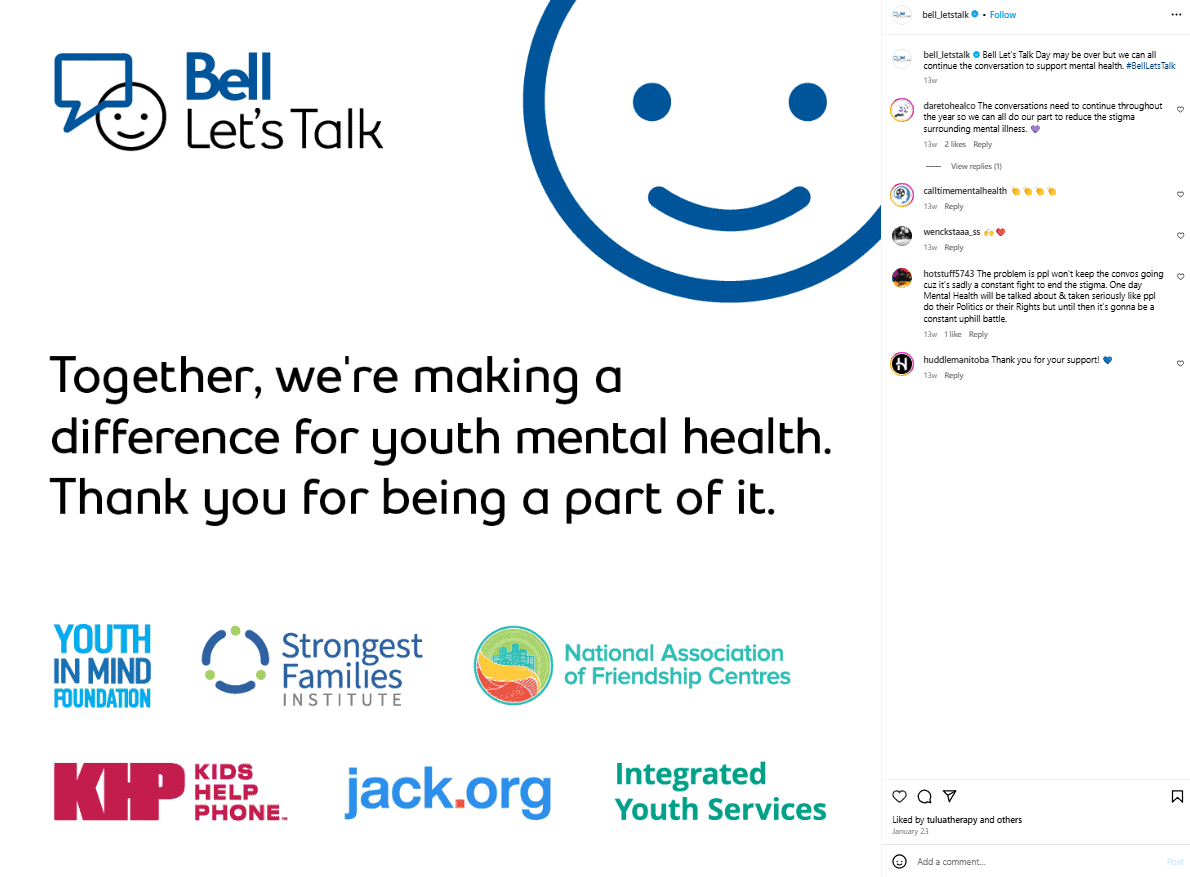
Source
Promote Your Social Accounts Everywhere
Cross-promotion is a simple but often underused tactic to grow your social media following. Don’t assume your followers on one platform know you’re active elsewhere. Use posts, stories, and email newsletters to guide them to your other social channels.
Make sure your website and digital materials include clickable social icons. Promoting your channels across platforms keeps your nonprofit top of mind and can help turn passive viewers into loyal, multi-platform followers.
Run Low-Lift, High-Impact Contests
Contests are another powerful way to boost engagement and expand your audience. Ask followers to post photos, answer a meaningful question, or tag a friend to enter. Keep it easy to participate and make sure it aligns with your organization’s mission.
A thoughtful giveaway or meaningful challenge can get people involved while spreading your message to their networks organically.
A great example is the #Run5Donate5Nominate5 campaign by Run for Heroes in 2020. The campaign invited participants to run 5K, donate £5, and tag five friends. The simple challenge went viral during COVID-19 lockdowns and raised more than £7 million.
It inspired unity, fitness, and generosity during a time of global uncertainty.
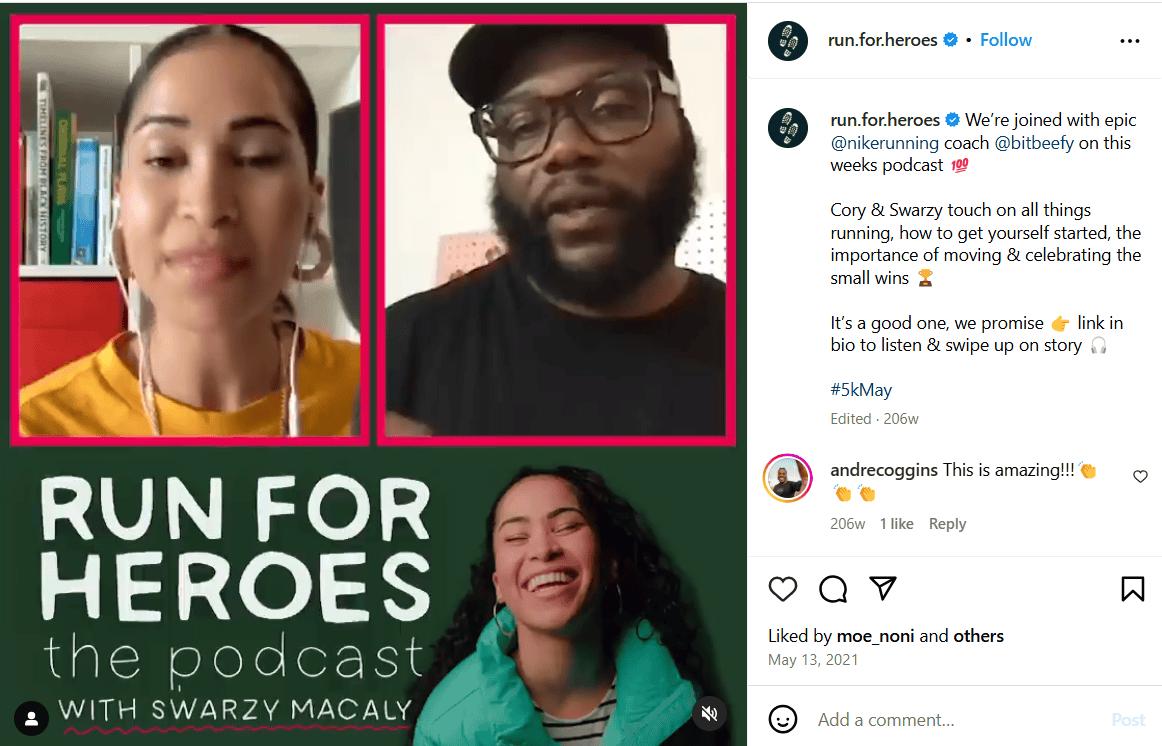
Source
Add Chatbots to Your Toolkit
Don’t sleep on chatbots, they’re not just for big brands. AI-powered tools can answer FAQs, accept donations, share updates, and engage users around the clock, even when your team is offline.
Take inspiration from Charity: Water’s Facebook Messenger bot “Yeshi,” which educated users on the water crisis while guiding them toward action. With over a billion people using messaging apps like Messenger, integrating chatbots can give your small team superpowers.
Go Live to Show the Real You
People crave connection and nothing builds it faster than live video. Whether it’s a behind-the-scenes tour, a Q&A with your founder, or a celebration of a campaign milestone, live streaming lets your followers see the heart of your nonprofit in real time.
Live video is also algorithm gold. Social platforms prioritize live content, which means your message can reach more people with less spend. And remember, polish is not the goal. Authenticity is.
Be Human, Not Just a Brand
In a crowded digital space, authenticity wins. Talk like a human not a brand guide. Use humor, show gratitude, and let your supporters see the people behind the mission.
Short-lived content like Instagram Stories or Facebook Stories adds to that human touch. It doesn’t have to be perfect, just real. And when you treat your supporters like people, not just wallets, they’ll stick around and champion your cause.
Harness the Power of Video
There’s no denying that video dominates social media. Whether it’s a short clip highlighting your impact, a donor thank-you, or a powerful story from someone you’ve helped, video captures attention and emotions like nothing else.
Compared to just text and images, social videos receive 1,200 times as many shares. And viewers retain 95% of a message when it’s in video form, compared to just 10% when reading it. That means your message won’t just be seen, it’ll be remembered. Want to drive action? Just make sure to close with a strong, clear call to action because a good video not only inspires, it converts.

Source
Final Thoughts: Small Teams, Big Voices
You don’t need a full-time social media department to make an impact. You just need a clear plan, the right tools (hey, Bulk.ly 👋), and permission to show up as your real, passionate, imperfect self.
Get those right, and your small team can create a digital presence and real-world change that’s bigger than you ever imagined.






